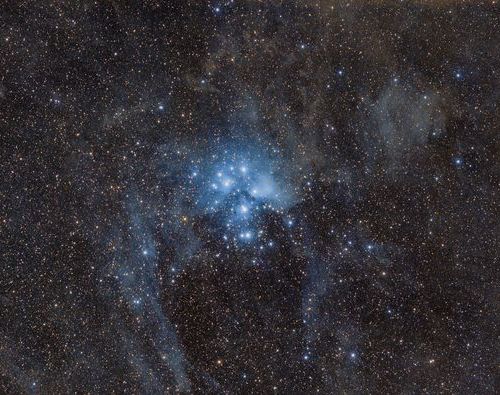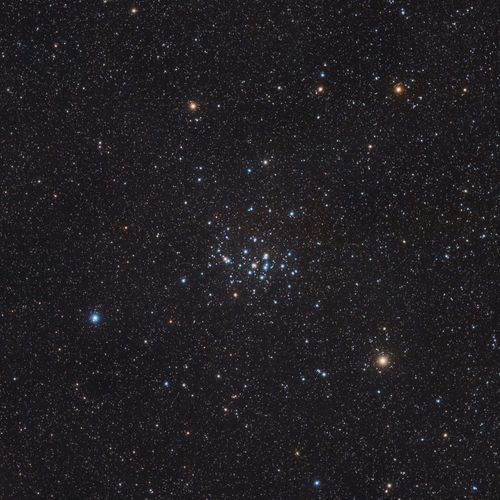Clusters
M45 ( Pleiades )
The Pleiades (/ˈpliːədiːz/,[7] /ˈplaɪədiːz/),[8] also known as the Seven Sisters and Messier 45, is an open star cluster containing middle-aged, hot B-type stars in the north-west of the constellation Taurus. It is among the star clusters nearest to Earth, it is the nearest Messier object to Earth, and is the cluster most obvious to the naked eye in the night sky.The cluster is dominated by hot blue and luminous stars that have formed within the last 100 million years. Reflection nebulae around the brightest stars were once thought to be left over material from their formation, but are now considered likely to be an unrelated dust cloud in the interstellar medium through which the stars are currently passing.[9]Computer simulations have shown that the Pleiades were probably formed from a compact configuration that resembled the Orion Nebula.[10] Astronomers estimate that the cluster will survive for about another 250 million years, after which it will disperse due to gravitational interactions with its galactic neighborhood.[11]Together with the open star cluster of the Hyades, the Pleiades form the Golden Gate of the Ecliptic.
M3
Messier 3 (M3 or NGC 5272) is a globular cluster of stars in the northern constellation of Canes Venatici. It was discovered on May 3, 1764,[8] and was the first Messier object to be discovered by Charles Messier himself. Messier originally mistook the object for a nebula without stars. This mistake was corrected after the stars were resolved by William Herschel around 1784.[9] Since then, it has become one of the best-studied globular clusters. Identification of the cluster's unusually large variable star population was begun in 1913 by American astronomer Solon Irving Bailey and new variable members continue to be identified up through 2004.[10]Many amateur astronomers consider it one of the finest northern globular clusters, following only Messier 13.[1] M3 has an apparent magnitude of 6.2,[4] making it a difficult naked eye target even with dark conditions. With a moderate-sized telescope, the cluster is fully defined. It can be found by looking almost exactly halfway along the north-west line that would join Arcturus (α Boötis) to Cor Caroli (α Canum Venaticorum). Using a telescope with a 25 cm (9.8 in) aperture, the cluster has a bright core with a diameter of about 6 arcminutes and spans a total of double that.[1]
M44 ( Beehive Cluster )
The Beehive Cluster (also known as Praesepe (Latin for "manger"), M44, NGC 2632, or Cr 189), is an open cluster in the constellation Cancer. One of the nearest open clusters to Earth, it contains a larger population of stars than other nearby bright open clusters. Under dark skies, the Beehive Cluster looks like a small nebulous object to the naked eye, and has been known since ancient times. Classical astronomer Ptolemy described it as a "nebulous mass in the breast of Cancer". It was among the first objects that Galileo studied with his telescope
Double Cluster
The Double Cluster (also known as Caldwell 14) consists of the open clusters NGC 869 and NGC 884 (often designated h Persei and χ Persei, respectively), which are close together in the constellation Perseus. Both visible with the naked eye, NGC 869 and NGC 884 lie at a distance of 7,500 light years.[1]



